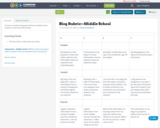
A rubric in student language written for middle school students to self-assess their blogs.
- Subject:
- Arts and Humanities
- English Language Arts
- Material Type:
- Assessment
- Date Added:
- 06/27/2017

A rubric in student language written for middle school students to self-assess their blogs.
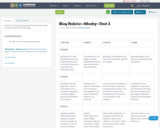
A rubric in student language written for middle school students to self-assess their blogs.

Writing is a time-honored tradition. It can be so much more than a few paragraphs about what you did this summer. What are some of your favorite stories? Movies? Songs? Websites? All of these were written by someone. But, few were written in one fell swoop. Brainstorming is a widely used practice for generating ideas. In this lesson we will be letting our imaginations run wild. One of the most important aspects of writing is knowing what you are going to write about.

Break it Down asks students to demonstrate their explanatory and descriptive writing skills.
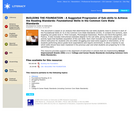
This document is based on an analysis that determined the sub-skills students need to achieve in each of the Foundational Skills (K–5) in the Common Core State Standards (CCSS). It contains five sections, each targeting one grade level in: Print Concepts, Phonological Awareness, Phonics and Word Recognition, and Fluency. It also includes instructional examples aligned to the sub-skills, giving teachers samples of activity types that facilitate acquisition of the sub-skills. Each chart includes up to three grade levels to inform instruction for students who are either struggling and need extra support or intervention, or for students performing above grade-level expectations and require enrichment, to allow a teacher to see which skills should have been mastered in the previous year and what students are preparing for in the upcoming years.

This collection of primary resources and corresponding activities sheds light on the endurance of peaceful protesters in Montgomery, Ala., who overturned an unjust law.
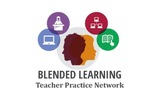
In this problem-based learning module, students will use their knowledge of the ancient Roman Empire and will work to analyze critical theories historians agree contributed to the fall of Rome. Students will then work to compare the problems faced by the Romans with problems citizens of the United States still largely face today. Through this investigation, students should recognize how modern technology, government agencies, laws and resources help to solve societal problems that could have once destroyed an empire. With this new understanding, students should work to present a solution to a major problem that plagued the Roman Empire during the years leading up to its collapse.Remix Resource uses key South Carolina standards for 6th Grade Social Studies and Language ArtsOriginal Resource uses key Ohio standards for 7th Grade Social Studies and Language ArtsAuthor: Blended Learning Teacher Practice Network Date Added: 07/23/2018License: Creative Commons Attribution-NonCommercial 4.0 Language: English Media Format: Audio, Downloadable docs, Graphics/Photos, Text/HTML

CashOnHand - Glossary - Billy - Spanish
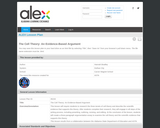
This lesson will require students to research the three tenets of cell theory and describe the scientific evidence that supports this theory. After students complete their research, they will engage in all steps of the writing process, including prewriting, outlining, revising, and editing. At the conclusion of the lesson, students will create a three-paragraph argumentative essay to examine the cell theory and the scientific evidence that supports this theory. This lesson results from a collaboration between the Alabama State Department of Education and ASTA.

This lesson discusses common characteristics and stereotypes that are associated with athletes.

Students identify individuals in their own lives who embody heroism and think about the various roles people play in conflicts.
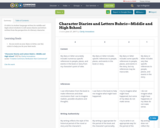
A rubric in student language written for middle and high school students to self-assess diaries and letters written from the perspective of a literary character.

This lesson, designed for middle level, goes into further detail about narrative characters and what characterization is. The lesson connects to Cornell notes along with discussion questions that students complete while watching in order to prepare for class the next day

This activity is designed for use with our free curriculum kit, Mighty Times: The Children's March, designed for the middle and upper grades.
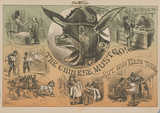
Signed on May 6th, 1882 by President Chester A. Arthur, the Chinese Exclusion Act was the first law to explicitly limit immigration based on race. This lesson is designed to go further in exploring the causes and effects of the Chinese Exclusion Act through analysis of primary and secondary sources. The purpose is to showcase the conditions in the US that led to a rise in xenophobia, and in turn, race-based policies that defined the Chinese American and Asian American experience in the United States. The lesson will also have students engage in critical thinking through research and a class discussion comparing and contrasting the Chinese Exclusion Act and current immigration policies or proposed immigration policies.
2021 Social Science Standards Integrated with Ethnic Studies:
Civics and Government: 5.1, 6.4, 7.5, 8.7, 8.8, HS.1, HS.2, HS.9, HS.10
Economics: 7.8
Geography: 5.13, HS.51
Historical Knowledge: 5.22, 6.20, 6.21, 8.22, 8.25, HS.52, HS.64
Historical Thinking: 7.25, 8.31, HS.68
Social Science Analysis: 5.26, 5.27, 6.24, 6.26, 8.34, 8.36, HS.72, HS.73, HS.74

In this lesson, students will learn about the Los Angeles Chinese Massacre of 1871, and identify the causes by examining the attitudes and policies of the time. They will learn about and analyze other massacres that have occurred in the United States in order to gain a better and more nuanced understanding of how and why these acts of violence occur. Lastly, students will research the process for reparations and consider how to address and rectify the harm of such injustices.
2021 Social Science Standards Integrated with Ethnic Studies:
Civics and Government: HS.2, HS.9
Geography: HS.42, HS.51
Historical Knowledge: 6.20, 6.21, 8,22, 8.25, HS.52, HS.53, HS.64, HS.65
Historical Thinking: 7.25, 8.30, 8.31, HS.67, HS.68
Social Science Analysis: 6.24, 6.26, 6.27, 6.28, 7.27, 7.28, 7.29, 7.30, 8.33, 8.34, 8.36, HS.71, HS.72, HS.73, HS.74, HS.75

In this interactive unit, students are introduced to the various factors and elements that contribute to a company's success by creating a product to sell. Students participate in a mock business venture from beginning to end - from making the product (a candy bar) to selling the product. Some math concepts and principles include:using proportional relationshipssolving multistep problemsdetermining percents, markup, and taxFurther, students apply English Language Arts standards to their finished product, including:designing a marketing posterwriting, recording, and presenting a sales pitch

Using recipe steps and food to teach 6th Grade students how to effectively write expository text demonstrating sequence, transitional words, while using proper grammar, and punctuation.

In this lesson, students will examine the cliques within their school community. They will also explore ways to integrate the student body and form relationships across, and in spite of, controlling cliques.
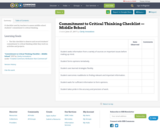
A checklist used by teachers to assess middle school students’ commitment to critical thinking.